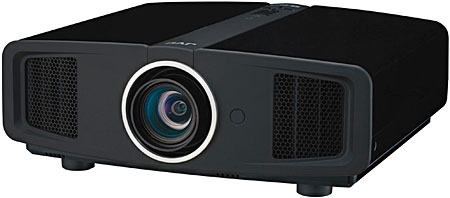JVC DLA-HD100 D-ILA Projector

Oh, I might wish for more-accurate color. The color gamut of the HD1 is too wide, though the visual result is not unpleasant and, like a speaker with a bit too much juice in the deep bass and extreme highs, it can be addictive. A little more flexibility in the color-temperature adjustments would also be nice. And please, sir, can I have some more of those rich blacks without compromising the projector's already exceptional peak contrast ratio?
Features
Priced at $8000, the next-gen DLA-HD100 has an identical twin in the DLA-RS2, which differs only in that it is distributed through professional rather than consumer channels. The match between these models is even closer than between the DLA-HD1 and RS1 (the pro version of the HD1). I will refer only to the HD100 in the remainder of this review since that's the model I looked at. But all comments should apply equally to the RS2.
Of course, the HD100 shares a number of attributes with the HD1 that I covered in my review of that projector, such as LCoS technology, video controls, lens throw, masking and overscan, 1080p/24 capability, the remote, and the input compliment, which I won't repeat here. Check out that review for more information on those subjects.
By reducing the crossover of stray light between the pixels, the HD1 And RS1 sported a specified peak native contrast ratio of 15,000:1. The new HD100 ups the ante to a specified peak native contrast ratio of 30,000:1.
There is no user-adjustable or dynamic iris in any of the JVC projectors. Apart from the Contrast setting, the only control over light output is a two-position brightness adjustment for the 200W UHP mercury lamp. The High position is about 15% brighter than the Normal position.
The most significant upgrade to the HD100's controls (relative to the HD1) is its enhanced gamma adjustments. In addition to the Normal gamma setting—which produces a measured gamma of approximately 2.1 across most of the brightness range—there are three other factory presets, Theater1, Theater2, and Dynamic, plus a Custom setting. The Custom mode lets you choose a gamma value from 1.8 to 2.6 in 0.1 steps. You can also fine-tune the selected gamma value using an onscreen graph, including overall gamma as well as red, green, and blue gamma.
The JVC's Pixel Adjust feature can change the overall position of the red, green, and blue images separately in 1-pixel increments. However, if the misalignment is not an integral number of pixels—that is, if it's off by some fraction of a pixel—you might be able to improve the alignment, but you won't eliminate it. By contrast, the Sony VPL-VW200 lets you align the red, green, and blue pixels independently by zone in increments of less than one pixel, but that projector is nearly twice the price of the HD100.
There's also a so-called V-Stretch aspect-ratio setting, which is not on the HD1. This feature vertically stretches a 2.35:1 movie to fill the imaging chips, eliminating the top and bottom black bars. To restore a properly proportioned image, you must add an anamorphic lens (optional) and a 2.35:1 screen.
- Log in or register to post comments





























































